Sometime around 9/111, I attempted to microwave myself a frozen bean and cheese burrito. My ten year old eyes gazed down at the instructions printed on the bright, plastic wrapper:
From Frozen
Microwave Oven: 3 minutes
Conventional Oven: 30 minutes
At this point in my life, I did not know what conventional meant2. I looked from the microwave, to the oven, then back again to the microwave. Hmm. Tough one. The microwave looked pretty “conventional” to me. Modern, one might say. A modern, conventional oven. The oven of the future. Soon, I felt certain: a microwave is a conventional oven, and — as crazy as it sounds now — an oven is a microwave oven. I popped my frozen burrito into the microwave, set it to cook for 30 minutes, and retreated to my room to watch Star Wars Gangsta Rap. 20 minutes later, dark, stinking black fumes filled our entire apartment. When my mother returned from work, she was not happy. For weeks thereafter, the kitchen reeked of smoke, burnt bean, and dumbass.
Perhaps unrelatedly, for most of my adult life, I forgot about bean and cheese burritos. Then, a few years ago, someone very dear to me brought me to High Tech Burrito in Mill Valley. It wasn’t the kind of restaurant I would seek out on my own3, but my companion insisted there was one item there I needed to try: the itty bitty beanie (or, as we called it, the “beanie cheesie”). It was a pocket-sized bean and cheese burrito no longer than the length of one's hand4. I looked upon it — the first B&C I’d held in about a decade. As my lips wrapped around the soft flour tortilla, I severed it with my teeth, and as my tongue and lips found soft bean and cheese, a door to nostalgia and easy pleasure that had long been shut was opened. In that instant, I re-remembered an ancient, pre-consciousness truth: bean and cheese burritos are one of God's perfect foods5.
That initial bean and cheese burrito from High Tech — though in the grand scheme of things not the best B/C in the world — became a reliable comfort food for me, and ignited in me a yearning to track down the perfect bean and cheese burrito. I began seeking out places known for their versions of the dish6, and started ordering a B&C at every new Mexican restaurant I visited. From Marfa Burritos to the frozen aisle to all around San Diego and Los Angeles, beechies became a constant eating-out focus over the past few years. Each soft, pregnant burrito added a data point to my growing opinion on what makes the ideal bean and cheese.
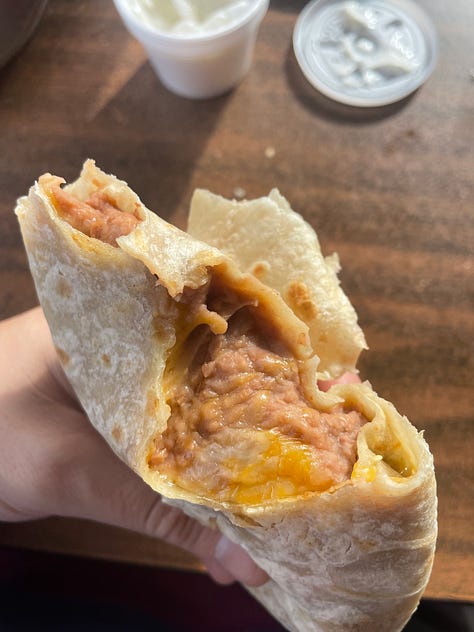
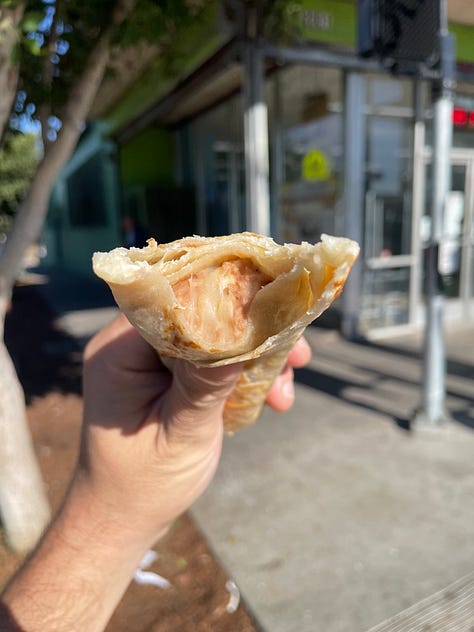

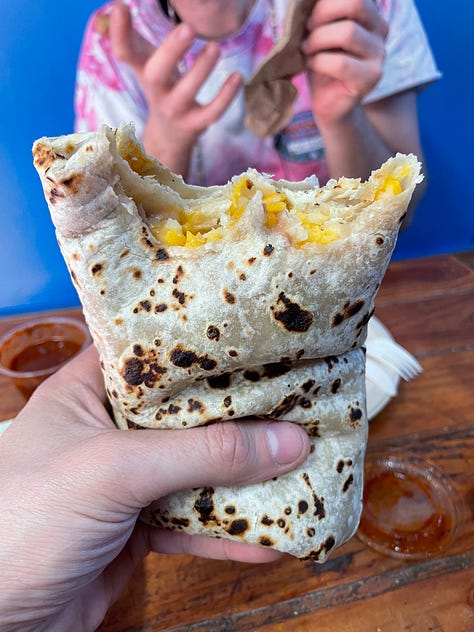


What was it that I was seeking? Some nostalgic platonic ideal hung in the back of my mind, an image of a burrito that I’m not sure I’ve ever even had, but rather was probably some composite of frozen burritos of childhood, Rubio’s bean and cheeses of youth, and stoned taqueria jawns of adolescence: gooey, orange-streaked, soft, warm, salty, almost tangy (??), creamy, rich, simply easy, and comforting.
Then one day, I had the closest thing I’ve found to the perfect bean and cheese burrito at Al and Bea’s in Los Angeles. It is incredible. From that burrito, and many other iterations I inhaled, I began to develop a clearer sense of my own taste. With that in mind, I present now an exhausting list of my opinions:
Beanium Cheezos are a great example of something being more than, as my friend Jacob would say, “the sum of its parts.” There is, however, a potential for it to be… simply its parts. Or even worse, less than the sum of its parts. With so few components, there’s no place to hide: each ingredient seems to require careful consideration… how it affects the balance of salt-savory-acid, the resulting textural contrasts and compliments.
I like when BC’s can pass the “flop test” — that when you hold it from its base, unsheathed, the top leans sideways almost 90 degrees. If the burrito is not lanky enough to pass / induce the flop test, I like witnessing its invertebrate quality as it recedes into itself, folding and collapsing inward under its own and gravity's downward force.
Besides their obvious nutritional and spiritual benefits, there is something womby and primordially pleasurable about bean and cheese burritos. I like how soft it is in there. I like when it’s so soft that you have to kind of rearrange its insides with your hand while you eat it — squeezing its bottom like a tube of toothpaste, pushing the bean and cheese filling up its tortillial canal while at the same time forming a vacuum seal with your lips and lightly sucking the filling up and inwards as you disconnect the tortilla with your teeth.
I like that sometimes the bean and cheese mixture cannot be contained, that the zealousness and force of the eater’s grip can transform it into a sort of non-Newtonian fluid that inevitably burst through the tortilla as if through some secret orifice, escaping then squeezing between your closed fingers like Alice Mack melting and sliding smoothly through the gap beneath a closed door.
Tortillas should be flour and of the highest possible caliber. I prefer thin, flaky, griddled tortillas for these as opposed to the fluffier kinds you sometimes find in Texas. I also do not think that the tortilla should be griddled so hard that it forms a “crust” that keeps the burrito from passing the flop test and creates potential for gashes and terminal breaks in the burrito's structure. An exception to this rule: I sometimes like when the outside is crisped just enough that, as you hold it, you can see the bean-cheese filling start to sink and create a little cavern where your next bite should be. A perfect place for some salsa.
Beans should be refried (or, really, singularly “fried”), ideally well-seasoned and most likely made with lard. I once had a BC whose beans were undercooked when they were mashed, yielding grainy, slightly hard pieces of bean floating in loose bean sauce. Unacceptable. I also really don’t like to have any whole pinto beans in there — saucy pinto beans belong on the plate, not in a bean and cheese burrito. Yuck. Some chunk or fleck is okay, but my favorite is when the BC filling is a thick, stretchy puddle of savory goop, when the bean and cheese meld and become one, or at least mostly indistinguishable from one another.
Cheese stumped me for a long time. What would the “classic” or “ideal” cheese be here? Mexican Blend? What is that anyways7? In Mexico, I imagine they might use something like quesillo (Oaxacan cheese), or maybe… a queso fresco / panela situation? Upon reflection, I remembered that many disappointing versions used a white cheese. Okay, so — orange felt right to me8. Colby Jack? I wondered. Then, on a research trip to Al and Bea’s this week9, I worked up the courage to ask the cashier what type they used. “Sharp cheddar.” WOW. I was reeling. Sharp cheddar seemed so out of place. Then, I remembered the sharp cheddar on the table when my mom would make Mom Tacos growing up. It all started to make sense: the acidity of a sharp cheddar could bring the tang, a much needed edge and balance to the richness of the beans that BC’s are so often lacking. The kind of tang that begs you to return for more. Plus, if it was good enough for Al and Bea’s, it was good enough for me.
At its highest level, B&Cs don’t need anything more than good beans, cheese, and tortillas, besides maybe a good salsa10.
After all that outward searching, my pursuit of the ideal B&C has now brought me home, to try and make the bean and cheese burrito of my dreams out of my own kitchen. As I started to think through my approach, one consideration came to mind: how much work does a taco shop actually put into their bean and cheese? Are they making their own tortillas? Usually, probably not. Their own cheese? Even more unlikely. Are they soaking their own beans or just zhuzhing up some canned beans? I’m sure it varies. But, then again, the quality of bean and cheese burritos in restaurants varies wildly, too. So maybe it was better to think: what would a caring parent or grandparent, with time on their hands and love in their hearts, do at home? I imagine they’d do it proper style…
And so, today I made an attempt to make my ideal bean and cheese burrito at home. I watched lots of videos, read threads and recipe overviews, and picked up some tips, tricks, and best practices. You can find my methods below — a first true attempt, with many more to come, I’m sure.
Bean and Cheese Burritos:
Bean:
You can’t have a bean and cheese burrito without beans. That would be a quesadilla or a cheese burrito. So, beans were my first step. I soaked half a bag of Rancho Gordo pinto beans overnight in twice as much water, and the next day drained and rinsed them, before covering with fresh water and placing on the stove over medium heat.
My aim was to try and approximate Al and Bea’s beans — tootsie-roll brown and impossibly rich (their beans, it seemed to me, were shiny and pudgy with lard). With that in mind, I reached for a large cube of cured pork back fat I’ve had kicking around in my fridge for a few months. I trimmed all around the outside to shed any potential refrigerator smells, and cut a large piece into about a ¼ cup of fat squares. I added that to the beans along with ⅙ of a white onion sliced thin, a couple smashed garlic cloves, some garlic and onion powder, a few big pinches of salt, and a little sprig of oregano. I learned my ABC’s about Bs from A&B’s B&CBs — you see, they are so incomprehensibly flavorful, and I hoped the cured pork fat, herbs, and slow-cooked sweetness of the alliums would be a good base layer of savory awesomeness in my beans. Some of those qualities might fade into the background, though, so I’d also try to get some darker, more savory flavors during the bean-frying process.
And so: as the beans were getting soft, I fried another ⅙ onion and two cloves of garlic in two generous tablespoons of rendered pork lard. Once the beans were soft, I strained and added them to the pan with the onions and garlic. I started mashing the beans with the back of a spoon, then, remembering how liquidy and uni-textural A&B’s were, I decided to transfer everything to a blender. After a whiz, the bean mixture was pureed (too soft?? unsure...) and flecked white, perhaps with all the onion and pork fat. I then cooked that mixture down in the pan until it was a deeper, homogeneous brown. I gave it a taste, added some chili flake (having seen a lot of people in videos adding fresh chili during the frying process), some MSG and more garlic and onion powder (for lack of ‘chicken powder’ some people add), realized I’d cooked it down too far, added more bean water to loosen11, and adjusted with salt. My final color wasn't as deeply dark as Al and Bea's12 (mine was closer to a Wendy's frosty than tootsie roll… perhaps because of all the snow white pork fat I’d added), but you know what? They were prettyyyyyy goooood!.

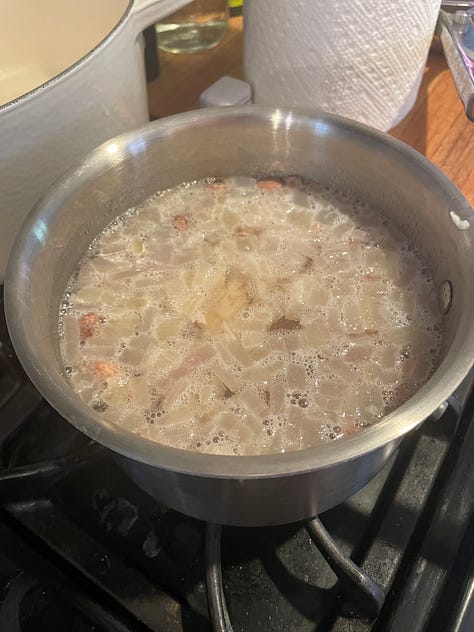
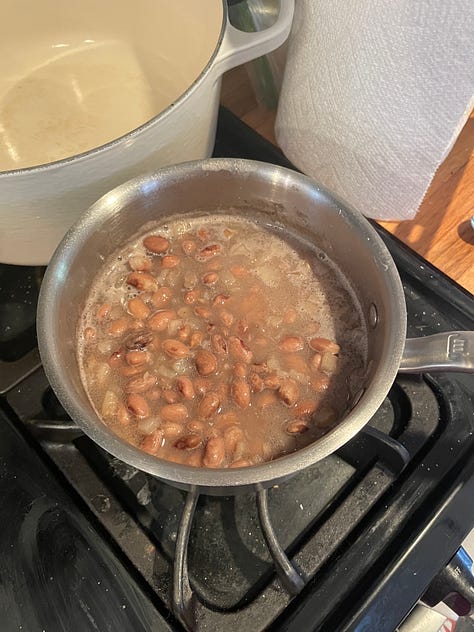



Cheese:
At Jon's international market, I spent about ten minutes picking up and putting down several sharp cheddar options: pre-shredded (don’t they put horrible stuff in these bags?), Tillamook (hard to imagine a homey Mexican restaurant using Tillamook... plus.. could this be TOO sharp?), and another large brick of cheese by Golden California (a company I can basically find no record of online..). Did I even need a whole brick of sharp cheddar anyhow? Then I remembered that my cheese grater was in storage. Wonderful. Flustered, I ended up grabbing a plastic wrapped package of pre-sliced sharp cheddar (presumably cut from the large “aged cheddar loaf” behind the deli counter). I scratched my head at my decision as I walked out and headed towards the car, making a mental note for next time to hydrate well before I go out shopping.
Salsa:
To accompany my homemade bean and cheese burritos, I decided to make a batch of a kind of salsa that I’d made last week for the first time, basically by just adding tomato to my usual burnt tomatillo salsa, that I think would be called “salsa quemada.” And honestly? It rocks. Here’s my method:
Salsa Quemada:
Makes 1 quart
Place 8-10 tomatillos (out of their jackets, and rubbed under hot water to remove their sticky layer), 2 ripe tomatoes (just normal tomatoes…), a quarter of an onion (root end intact, skin left on, cut into two 1/8th onion wedges), 4 garlic cloves (papery skin left on), and two jalapeños (remove seeds I guess if you don’t like spicy) on a sheet tray. Cover with a little oil (I used avocado oil spray……..).
Broil on “Low,” as close as you can to the flame, until the garlic is softened but not browned or burnt. Remove the garlic, squeeze its meat into a blender, and continue broiling until everything is soft, liquidating, and starting to burn. Turn the broiler to high and broil until quite burnt (to your liking).
Blend everything (onion skins removed) to smooth and season to taste with salt (will need quite a bit), optionally adding garlic powder, onion powder, and MSG for tastiness. Once cool, stir in a big handful of rough chopped cilantro.

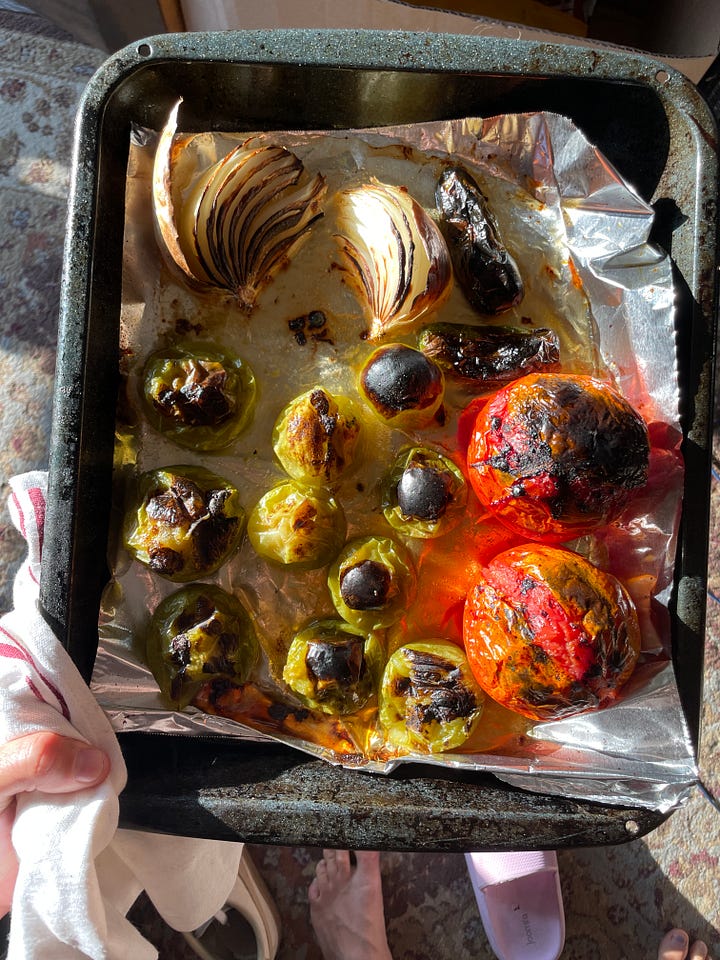
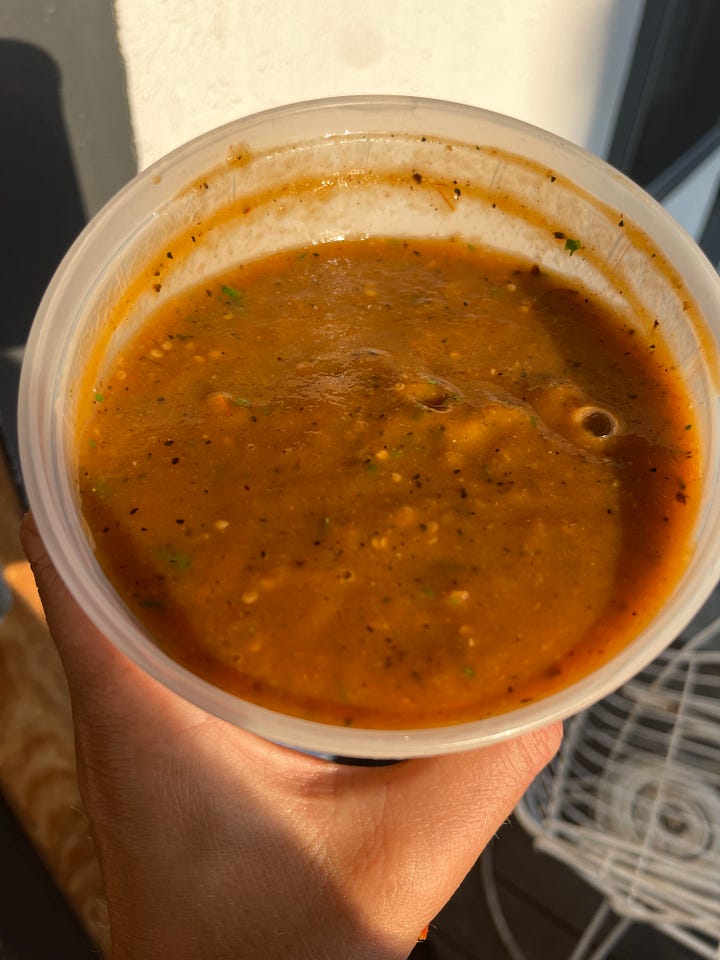

Tortilla:
I won’t explore the science behind flour tortillas here. I can’t take anymore food or baking theory after the biscuit trilogy13. I will say, though: flour tortillas are made by rubbing (usually saturated) fat (like lard or butter or shortening) into flour and salt, then binding that fatty flour together with water (sometimes warm, which I think makes the dough more pliable).
As I tried to hone in on a recipe, I spent many hours procrastinating studying videos of people making flour tortillas. This one — where a woman makes massive, thin, Sonoran flour tortillas on a rustic farm seemingly in the Mexican countryside — particularly captured my attention14. I’d like to make tortillas there, like that! I watched, fascinated, as she stretched the tortillas in her hands, then patted them back and forth, before pulling them thin — so thin — across the back of her arm and placing them onto the comal.
Today, as I set out to make my own flour tortillas, I basically followed her method. In her massive batch of dough, she seemed to use a 20:2:1 ratio of Flour:Fat:Salt; for my batch, that came out to 300 grams (about 2 cups) of flour, to 30 grams of cold lard (a big spoonful), to 15 grams of salt (a few big pinches). I smeared the salt into the lard (the lady says to use fine salt so the large crystals don’t mess up the dough… I’m not sure why [my Spanish only goes so far]…so I decided to dissolve my Diamond Crystal kosher salt into the fat, instead), and once dissolved, added the flour. Once all the lard had been smeared into the flour, the mixture looked and felt very similar to the texture of Kraft shitty Parmesan cheese: fluffy and, when moved around, forming lightly held together clumps.
At this point, I slowly added hot water as I mixed the mixture with my hand, until a very sticky dough had formed. I kneaded the dough on my cutting board until it was smooth and not at all sticky (or, just tacky enough to pick up any remnants of dough from the inside of the bowl), about 5 minutes. At this point, the dough smelled warm and fragrant like the (non-eviscerated) microwaved burritos of my youth. I formed it into a ball (I can’t explain the entire process in depth… I can’t… one must watch videos…), coated it lightly with lard (to keep it from drying out, and let it rest, and covered it with plastic wrap for about 30 minutes. After that, I divided the dough into ten smaller balls, rolled those up tight, coated them with a bit of lard, and let them sit covered for another 30-45 minutes.
At this point the dough was very pliable, and it was time to make my own flour tortillas. For the first few, I tried to follow the method that the woman had used in the video. It was…incredibly difficult and took me forever — forming the balls into UFOs, then trying to pat them back and forth into a thin, circular disk15. I was under-hydrated and cranky and getting very frustrated. Eventually, after longer than I’d care to share, I finished my first tortilla. It was paper thin in the middle and super thick around the edges. I tried to place it in the skillet and it crumpled. I ended up with an ugly, crimped, uneven tortilla. Amazing. I tore off the thick, undercooked edges, smeared the crackery inside portion with butter, and ate it quickly. Sigh.
I was sitting in bed demoralized when my friend Jacob reached out to check in on my bean and cheese progress. I complained about the tortilla stretching process, how difficult it was to get them evenly thin in the air, in my hands. Then I thought: well, wait… why didn’t I just roll them? I hung up, hopped out of bed, and began rolling out one of my dough balls (using my can of avocado oil spray as a rolling pin). It was, in a word: infinitely easier than what I’d been trying to do. The tortilla rolled out into an even circle (giving it a quarter turn after each up and down stroke), about as thin as I wanted it16, and with so much ease. YAHOO! I griddled one up. Beautiful, puffed with air, bubbly, pock-marked, soft, bendable. The perfect little canvas to begin…

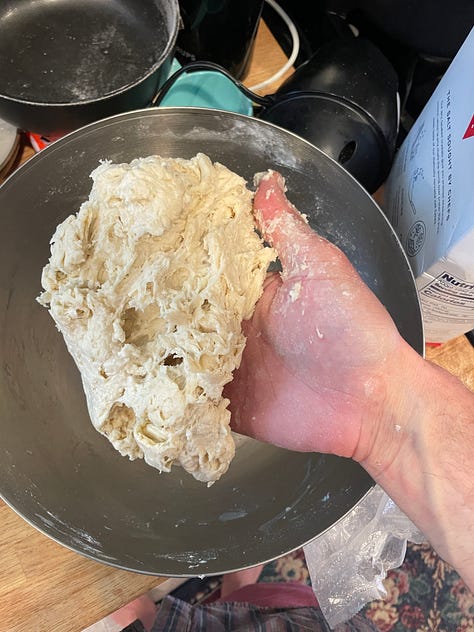

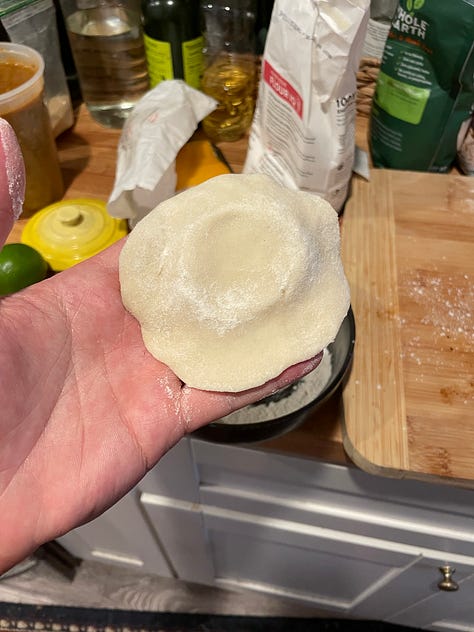


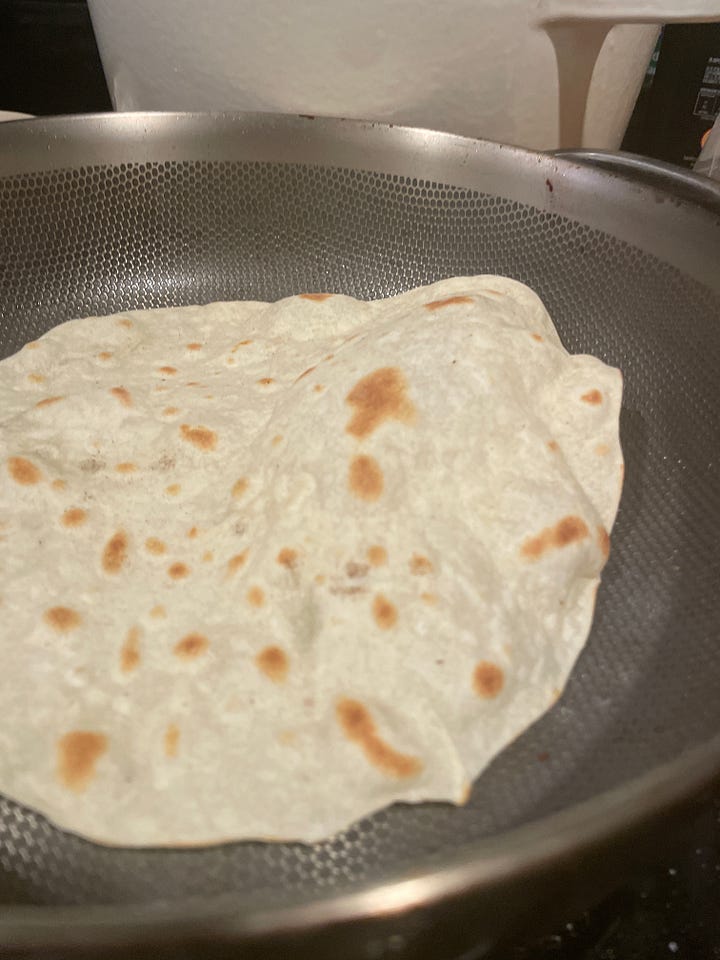

Assemblage:
I cut my sliced sharp cheddar cheese (which I'd been keeping room temp, all sweaty, to encourage easy melting) into semi-thin strips, in a deranged attempt to emulate the shape of shredded cheese. I looked at them. They looked weird. I put them into the warm tortilla, followed by two large spoonfuls of soft, molten hot beans, and a splash of my salsa quemada. I rolled it up, and brought it outside, into the sunshine. I lifted it to my mouth, wrapping my lips against the soft tortilla, sinking my teeth in, squeezing from the tush, and slowly sucking inwards…
WHAM! It rocked!! Flame city. I gave it the “flop test” — it sagged limply to the side. Success! I watched the filling sink down low in its skin the way I like it, felt hot beans and cheese (now become one, nearly indistinguishable) escape the tortilla and explode through my fingers as I squeezed and rearranged the burrito. It passed all the tests. And it was glorious.


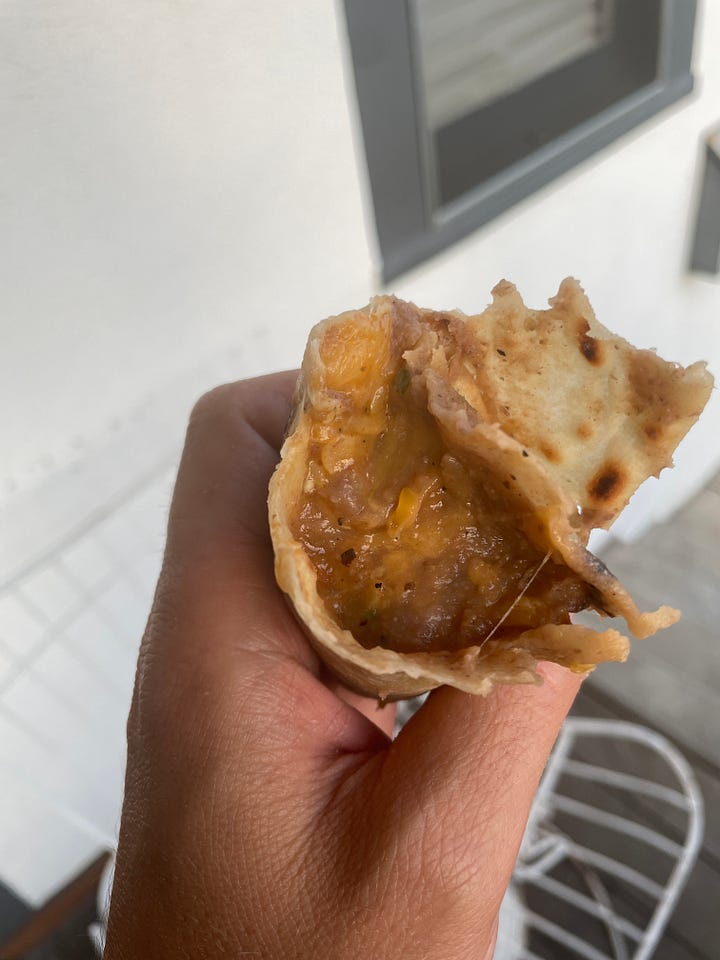
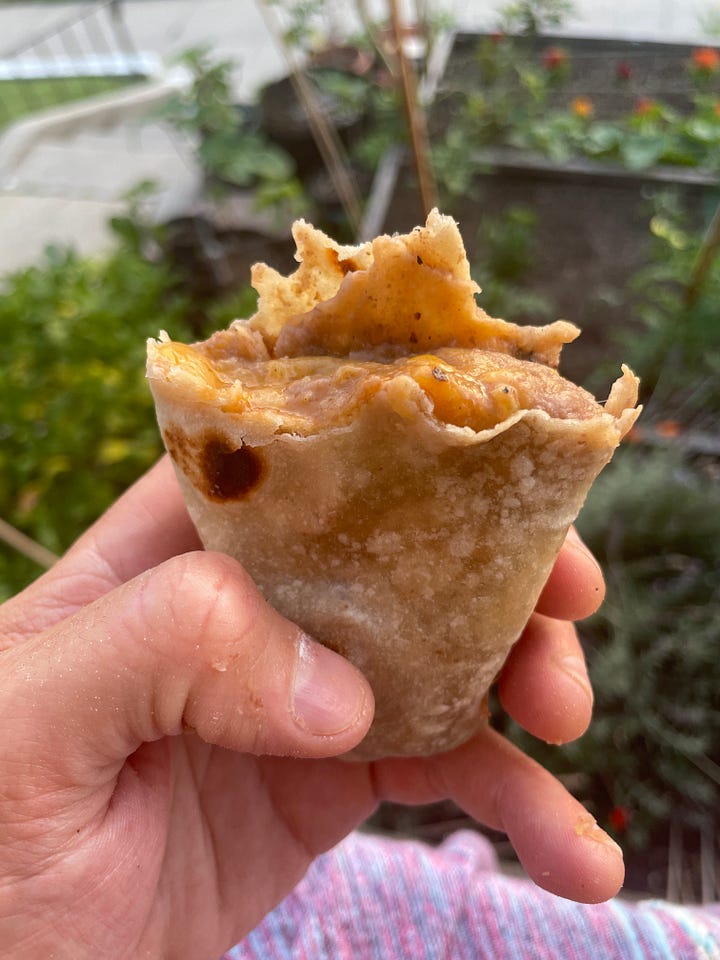
I hoovered my burrito and staggered back inside, beans in my mustache. Without much thought, I started making another one. I ate it quickly, and made one more17. I gazed down at it. Hm. It was just about as long as my hand. As long as my hand… as long as my hand! Damn. Without realizing it, I’d modeled my homemade bean and cheese burritos on the burrito that had started it all. I’d made itty bitties, my own personal beanie cheesies. And boy were they good.
Included because this is my only time marker for when we lived in the apartment where this burrito incident took place.
I actually just now had to look up the definition to this word, so maybe not so much has changed.
In fact, it was waving many red flags — from the general bougie, tech-y style of the restaurant and menu, to the words “fresh” and “healthy” being floated as descriptors, to the inclusion of sushi burritos, brown rice, wheat tortillas, tikka masala and Thai peanut and chicken teriyaki bowls on the menu…
This, in addition to making it incredibly cute, meant that you could probably eat many of them in one sitting, no questions asked.
In good company with: pigs in a blanket, chicken tenders, and I guess many of the things I write about here.
I really don’t like using this word, but I'm not sure what a proper alternative would be. Let me know if you have any ideas.
I looked it up, and while it varies a bit from brand to brand it’s often a mix of Monterey Jack (a Californian cheese), Cheddar (a British cheese), and two Mexican cheeses I hadn’t heard of: Asadero and Queso Quesadilla. I had a hard time finding good information on these, but it seems they are either interchangeable or very similar (and also similar to Queso Chihuahua and Queso Menonita, the latter of which is so-named because of the Mennonite community in Northern Mexico from which it originates).
A silly thought, as most orange cheeses are only that color because of annatto, an added food dye.
I went with my new friend Stephanie, who ordered a chile relleno burrito — my first time trying, absolutely divine.
Other possible additions:
Salsa — Al and Bea’s puts their red or green sauce inside their burritos, so this must be ok. I also like having my salsa on the side and don’t necessarily need it inside. But if you want to put a little, okay — but never salsa fresca.
Onion — Taco Bell adds small diced white Onion to their beeches. I like that.
Crunch - I’ve thought of the idea of putting chips or tostadas or a half crunchy taco shell inside one of these bad boys, for crunch and structure. An interesting Idea. Beanie cheesedita crunch. I’ve also thought about putting fried chicharrones inside there. That sounds… pretty good….
Rice and basically anything else: ABSOLUTELY NOT. These do not belong in a bean and cheese burrito — and some might argue that rice should never really be in any burrito.. except perhaps a chicken rice and cheese which I would, for nostalgia sake as it was served at my middle school, take a bite of.
Something to be aware of is that these beans tighten up as they cool, possibly as the lard moves back towards a solid. It can also be easy to over-salt. Better to start with less and add more after you've reached your desired texture.
How do they get them so dark brown??
The biggest science-y question I had was whether or not to use baking powder in my tortillas (many online recipes called for it). Ultimately, I decided against it, as it seemed like it could contribute to a puffy quality in the tortillas that I wasn’t looking for.
I did not understand the “patting/tossing back and forth” motion at all. What’s doing the stretching??
In the future, I'd consider trying this technique of rolling two tortillas at time.
I also made a cinnamon sugar tortilla with thick slices of salty french butter. Nostalgia unlocked and adapted — amazing.

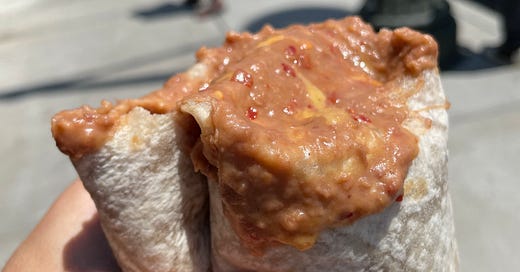




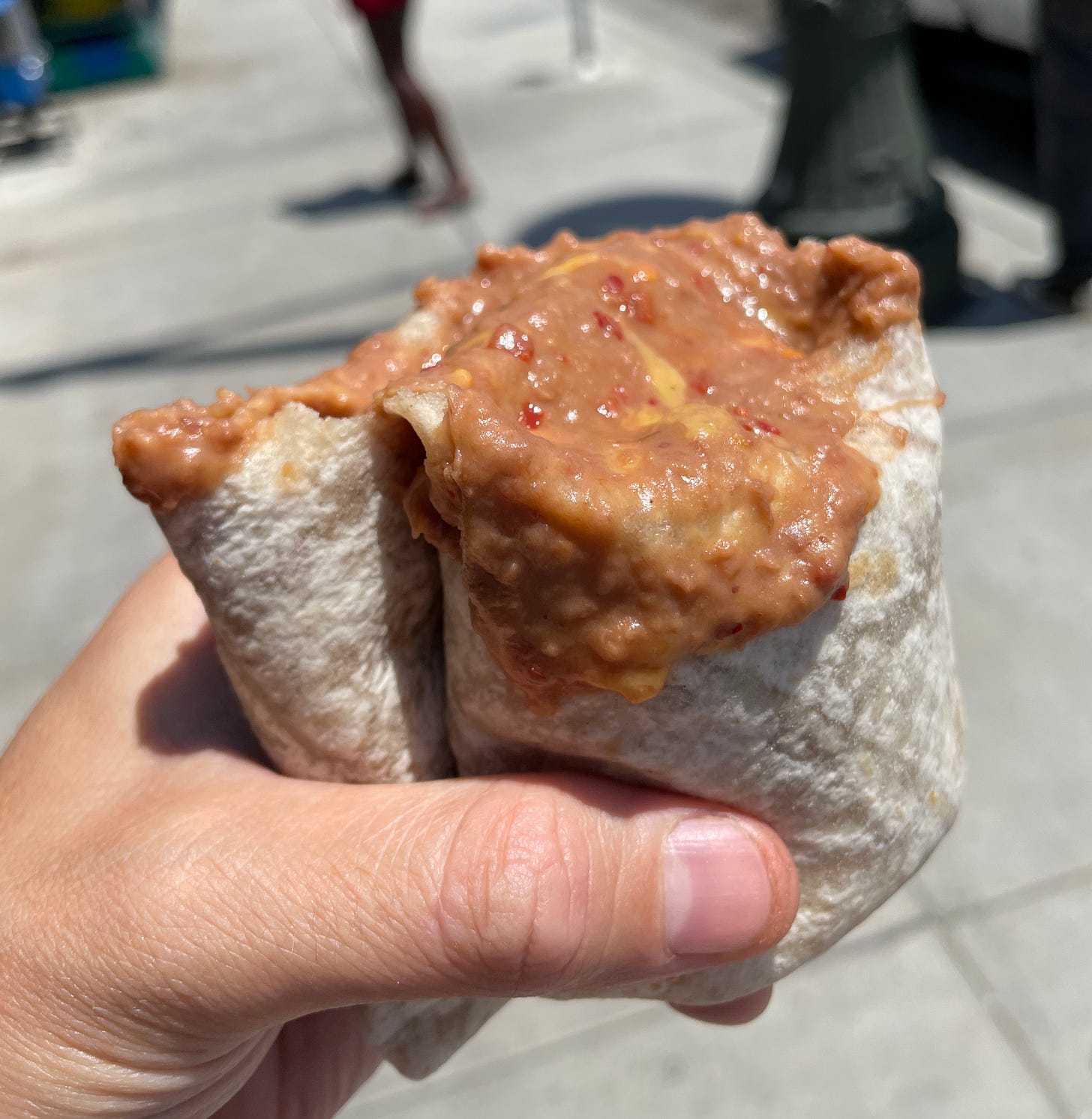
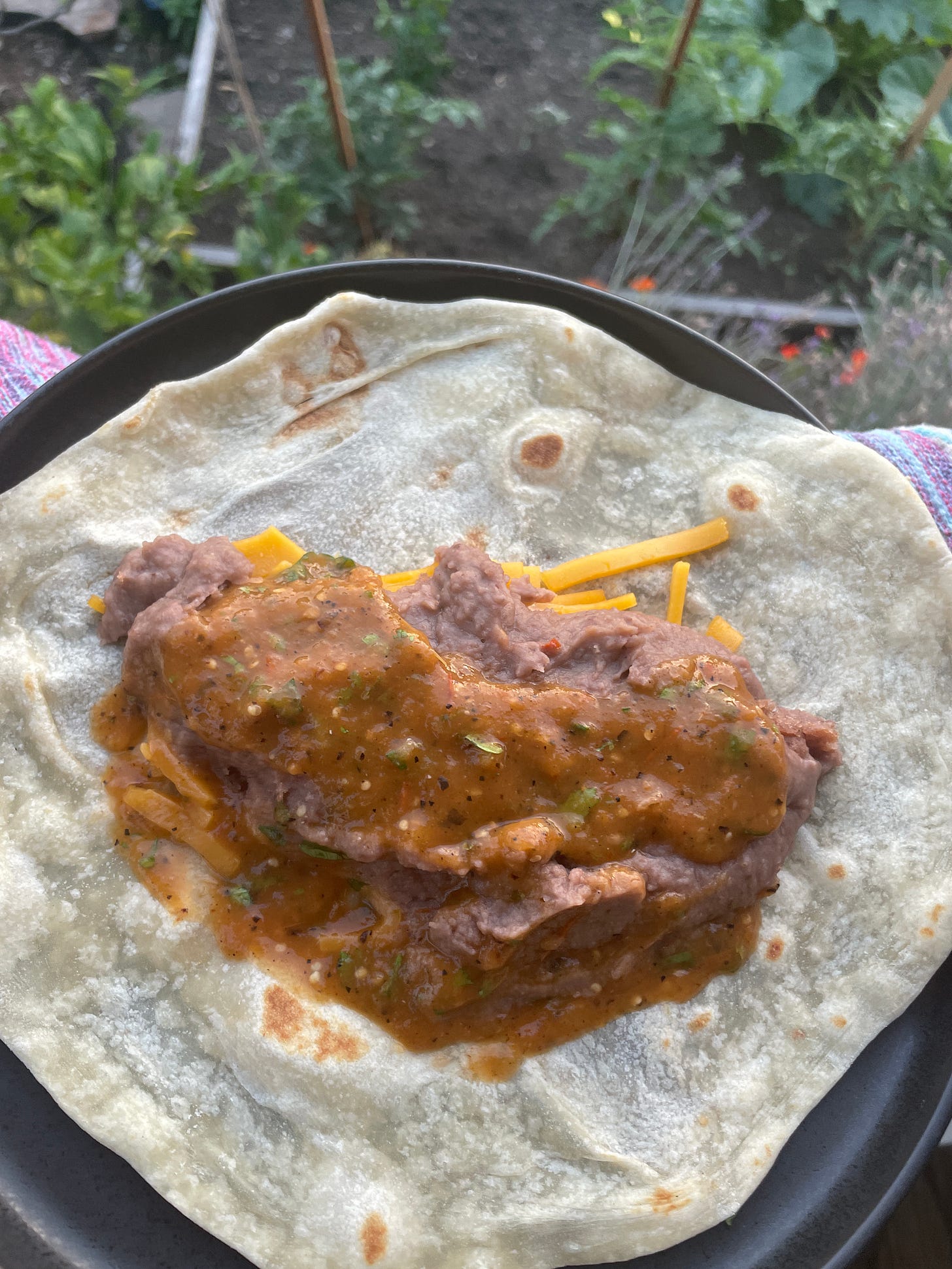

Another beautiful read!!! Keep em coming!!!
One of Cody's perfect writings 🙂↕️💐